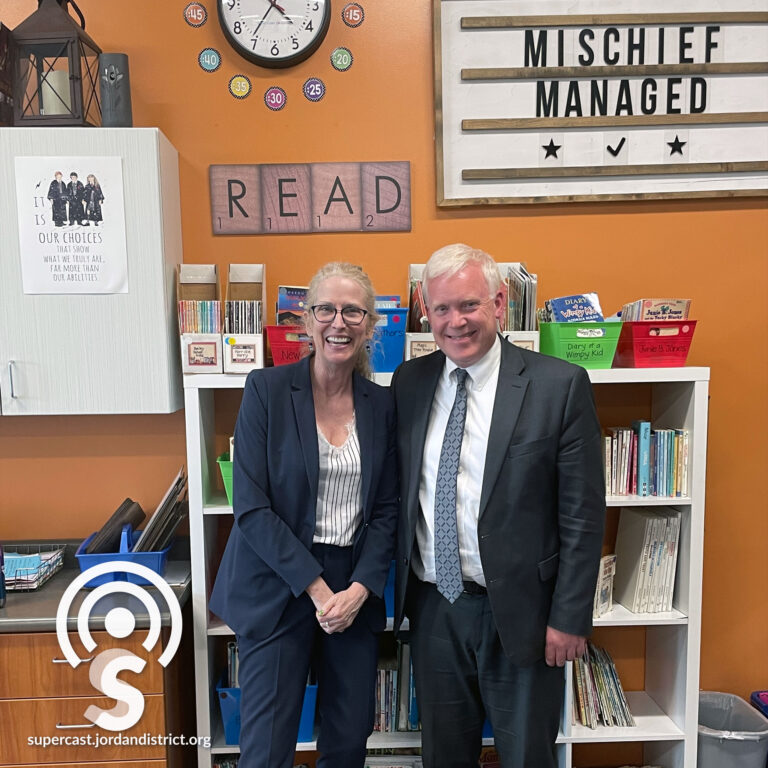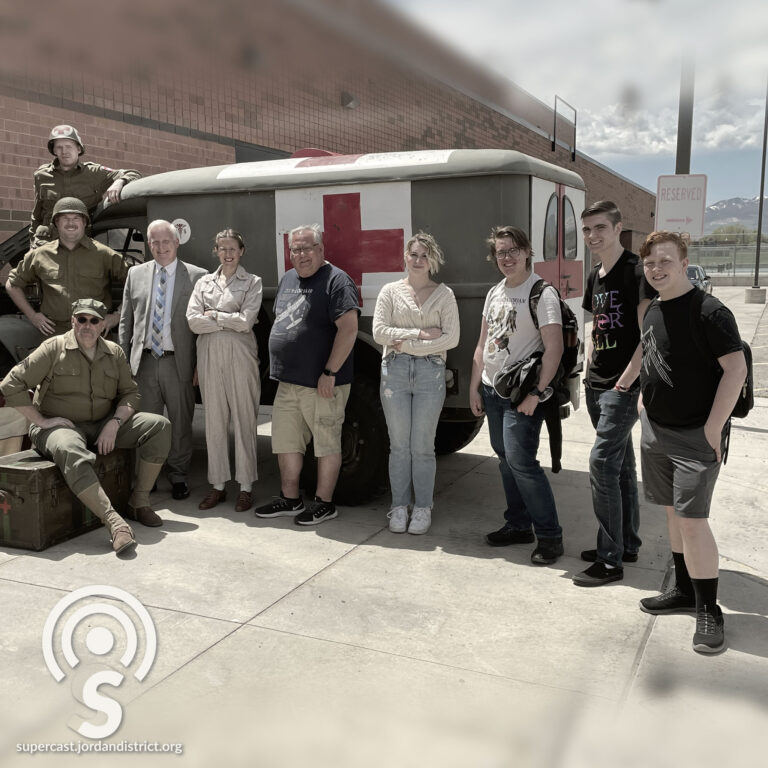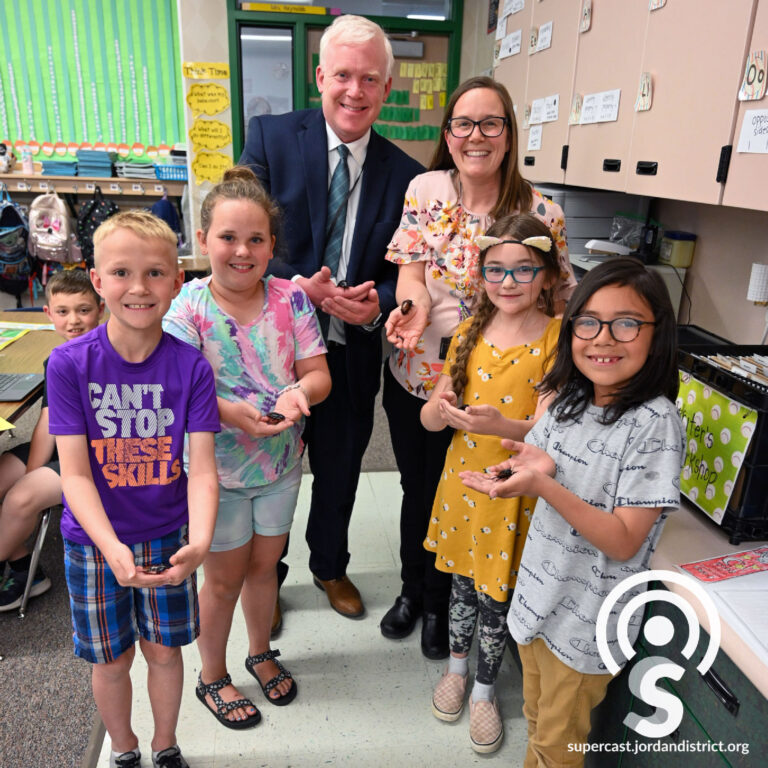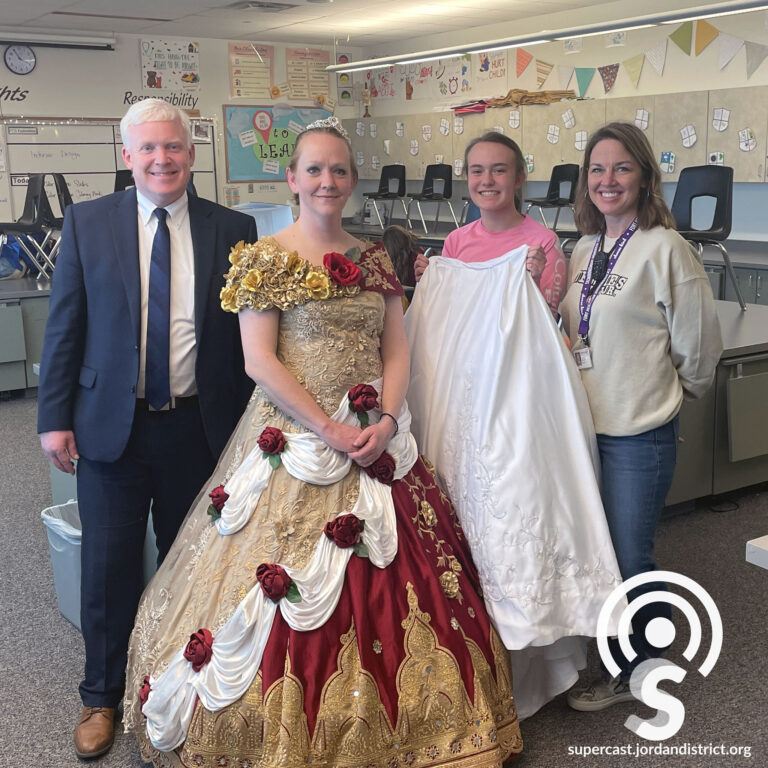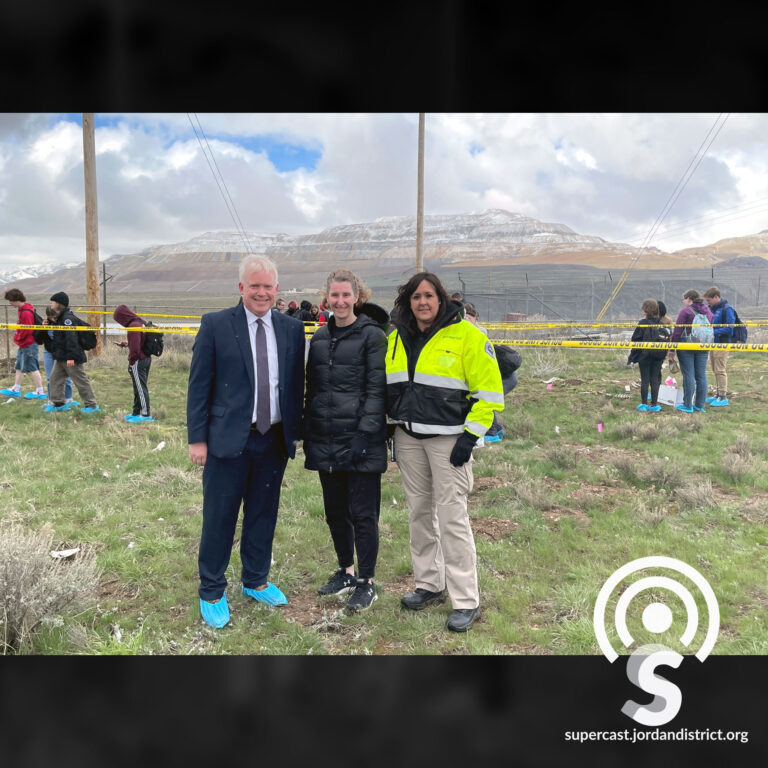She is one of the most recognized morning radio hosts in the Salt Lake Valley. Amanda Dickson has been a staple on KSL NewsRadio in the mornings for nearly three decades doing what she loves, connecting with people and sharing stories.
On this episode of the Supercast, we hear about a newfound passion for the popular radio host. Amanda Dickson is now spending a lot of her time off air, in the classroom as a substitute teacher. Find out why she says students bring her such joy and why she believes kids in the classroom can do the same for others willing to try substitute teaching.
Audio Transcription
Anthony Godfrey:
Hello and welcome to the Supercast. I'm your host, Superintendent Anthony Godfrey. She is one of the most recognized morning radio hosts in the Salt Lake Valley. Amanda Dickson has been a staple on KSL NewsRadio in the mornings for nearly three decades doing what she loves, connecting with people and sharing stories.
On this episode of the Supercast, we hear about a newfound passion for the popular radio host. Amanda Dickson is now spending a lot of her time off-air in the classroom as a substitute teacher. Find out why she says students bring her such joy and why she believes kids in the classroom can do the same for others willing to try substitute teaching.
I'm here with Amanda Dickson, radio personality for KSL and substitute teacher extraordinaire for Jordan School District.
Amanda Dickson:
I don't know about that.
Anthony Godfrey:
And I'm actually in a classroom at Golden Fields where you've been substituting today.
Amanda Dickson:
Yes, I'm here in Miss Beck's class, her third-grade class and we had a really good day today.
Anthony Godfrey:
It looks like it's decorated for Hogwarts.
Amanda Dickson:
Oh yeah.
Anthony Godfrey:
I don't know if it always is but the candles are floating in the air and pictures of children in robes are on the wall and it looks like a great environment.
Amanda Dickson:
Each group of tables is a different house like Slytherin, and this is Ravenclaw, and Gryffindor was particularly good today.
Anthony Godfrey:
No surprise there. That's how Gryffindor rolls. I have a lot of questions. So I assume that you interviewed me and others at Riverton High School not long ago, a few weeks ago, about just as part of your broadcasting out in the community. And that was a lot of fun. Everybody I talked with had a great time with that. I was amazed at how many things you can keep going all at the same time. You're talking to them, to the people on your earphones telling you what to do, you're connecting with me at the same time, you're looking at the screen, it's all happening in real-time. I suspect that prepares you very well to be a substitute.
Amanda Dickson:
Oh, that's brilliant. Yes, I think that doing, in fact, doing my show in particular, because we have to hit things at exactly the right time because people use us like a utility. So if they're not out the door by the time they hear three things, or traffic and weather, they know they're late, we have to be on time with those things. That makes us a little strange in the way we multitask because we're constantly looking at the clock and counting back in our heads, do we have enough time to do this? Will we hit at this precise time. I had a boss once that called me scatterbrained. I like to think of it more as multitasking.
Anthony Godfrey:
It's multitasking.
Amanda Dickson:
Multitasking, yes.
Anthony Godfrey:
Lots of people think they can do it and can't do it. I sit in a lot of meetings where people think they can be looking at the screen and be very aware of what's happening all at the same time. They can't, but you absolutely can. I have witnessed it. And like I said, I'm sure that those skills are very helpful when you've got lots of children that you don't necessarily know that you're dropping in on. And that's the difficult part, is that you're dropping in on an established routine, established relationships among the kids, and then you're the new person. So tell me a little bit about what that's like.
Amanda Dickson:
Oh, it's wonderful. I feel like a grandparent Dr. Godfrey because I get to take them for the day and then I give them back. “So nice having them. Here you go.”
Anthony Godfrey:
That's a great way to describe it.
Amanda Dickson:
Because I get to love them for a day and then I give them back to the teacher who is so responsible, so I get perfect instructions. I mean today was a perfect example. You do this for a half hour, this for 15 minutes, here's the instruction, these are the books. I mean, I'm given a perfect roadmap of what to do.
But you're right, if I don't connect with them, then it's a very long afternoon. So I have to find a way to connect with them. And sometimes it's just as simple as energy. If I listen to their reading enthusiastically, they'll come to where I am. But sometimes it's more difficult.
I had a great class today because these kids were obviously proud of their work, of their reading skill, of their writing skill, and they wanted to share it. And that's beautiful. And it's so different from the news if you'll forgive me for saying that. Because the news can be, as you well know, it can be very heavy and negative and at a distance. Substitute teaching is joyful and in-person and focused on the future and not on the past.
Anthony Godfrey:
I love the focus on the future that's exactly it and the impact that you have keeps rolling. You're building momentum with these kids with a positive interaction. Listening enthusiastically to their reading is a great example of that. And you know, this is not to downplay the difficulties of being in a classroom or being a substitute teacher. It's a very difficult job but you also have some degree of control over what the climate is for that classroom. How do I want it to feel? And you've described that. I want to connect with them. I want to be sure that they feel loved and that I'm connecting with them but then I'm also going through the instructions left by the teacher.
Amanda Dickson:
Right.
Anthony Godfrey:
That gives them a sense of comfort that those routines continue and they stay in place and the teacher's gone.
Amanda Dickson:
Yeah because they'll try and get away with things as you well know.
Anthony Godfrey:
The news doesn't allow you to do that.
Amanda Dickson:
No.
Anthony Godfrey:
Yeah, that comes at you and you have to deal with what's coming at you. But they do try to work it though. So what age do they try to work it the most?
Amanda Dickson:
Kindergarten on. I mean.
Anthony Godfrey:
All of the ages.
Amanda Dickson:
All of the ages in different ways. No junior high of course. It's junior high.
Anthony Godfrey:
Well, I was a middle school teacher so I do understand that at a deep level.
Amanda Dickson:
God bless you.
Anthony Godfrey:
I liked eighth graders. I know that is a rare person that loves eighth graders but I had a blast with eighth graders.
Amanda Dickson:
I have found many kids in middle school to love and classes to love, but those have also been some of the hardest experiences. Because I've been spoiled these 30-plus years at KSL that when I talk people listen to me. Until I went to middle school and then I realized this is a whole… They don't know who I am, they don't care who I am, they just want to see what they can get away with. And yet there are students of course there who are more shy and more studious. So how do you make, this is a question, how do you make it a good learning experience for those students who are applying themselves and address the difficulties, the behavioral issues at the same time?
Anthony Godfrey:
Well, you ask an important question. It's a question that I think teachers have to ask themselves constantly throughout the day. It's part of the stress of being a teacher. And you've understood this for a long time. At the end of the day, you've made so many decisions about, "Should I talk to that child? Should I talk to this child? Should I allow them to do that? Should I not?” That by the end of the day, you have decision fatigue. You're worn out. There's a lot of energy that goes into that.
I think what you have to do is connect with kids that aren't outwardly begging for it because there's behavior that is meant to draw your attention. There are kids who will try to draw your attention in other ways, but there are kids who are quietly working and doing what they're asked to do, not doing things to outwardly reach out for your attention. And if you actively give it to them, then that is very meaningful to those students who are quietly just doing what they need to. It takes time to do that, it's hard to do.
Amanda Dickson:
And in so many of your elementary schools, the teachers have set up processes for that.
Anthony Godfrey:
Yes.
Amanda Dickson:
You know, and told me specifically something very similar to what you said. You know, here are the marbles. Give them marbles when they're on task. Give them marbles when they're reading. Or give the class a point, or take it away. So that reward structure is, it's structured in elementary school. In middle school, not as much, but yeah, that's good advice. I'll use that.
Anthony Godfrey:
But you're right, the feedback structure, however that is, is really important to students. It's important to the teacher because it kind of allows everyone to feel engaged no matter what's happening. And then you get to focus on the content because you don't have to be worried about whether people are feeling like they belong in the class or whether they're connected with the adult in the classroom.
When I visit classrooms for Outstanding Educator awards, we visit every school every year. So all 68 schools, we stop and we have a group from the Foundation and I like to play around with the kids and have fun. And one of the things that really gets the teacher's attention is if I notice what their reward structure is. I see the box of, you know, bucks, the teacher bucks that get handed out or whatever rewards or treats. But I really admire how teachers structure their classroom for maximum belonging and maximum teaching. I'm continually impressed as I see that.
Amanda Dickson:
Me too.
Anthony Godfrey:
Even though I've been in education for three decades, it's amazing what they do.
Amanda Dickson:
I mean like in this classroom, you can see the love.
Anthony Godfrey:
You can.
Amanda Dickson:
If you never met this teacher and never met her students, the walls are filled with their names and their likenesses, and their accomplishments. And the books are organized by mystery, adventure, history, biography. But this is not unlike all the classrooms I'm in. It's a version of love in color.
Anthony Godfrey:
That's such a great way of putting it. And as I look around, I see evidence of love. I didn't notice it the first. Like, wow, they've got potion bottles.
Amanda Dickson:
Yes.
Anthony Godfrey:
And action figures and it really is a great way of describing it.
Amanda Dickson:
Yeah.
Anthony Godfrey:
Tell me, how long have you been substituting?
Amanda Dickson:
This is my first year.
Anthony Godfrey:
This is your first year.
Amanda Dickson:
Yes.
Anthony Godfrey:
It feels like you've been doing it for a long time.
Amanda Dickson:
I wish I had.
Anthony Godfrey:
You understand it so well, you've just connected with this job.
Amanda Dickson:
I love it so much more than I anticipated. I had had people, and I'm embarrassed to say this now, but I had had people tell me, "You're not gonna like this, you shouldn't do it. You're gonna hate substitute teaching, what are you thinking?” But we had stories at the beginning of the year about how there weren't enough substitute teachers. And I get done with work like 11, 11:30, and I thought, well, would I ever be able to do this?
So I contacted the District Office and I went through the training and I take every afternoon that's offered that I can get because it's so joyful. Mostly in elementary, but I do some middle and some high school. And those can be joyful on different levels too, as you know.
So I started this year and I found it challenging. I look forward to it. When I leave KSL and I value that job, I don't mean to say anything, I value that job very much, but I feel like I come into a place where my spirit almost belongs more, that it's a chance to, goodness, I'm emotional about it, but it's a chance to be with, my kids are mostly grown. My youngest is 16, my oldest is 34, and I miss kids of this age, I miss that light. I had four girls present today to the class with their poster and they were so good and so nervous and so creative and I miss that.
Anthony Godfrey:
It is a beautiful thing to get to see kids in action, to watch them learning, and to see them grow. It's what drew me to education.
Amanda Dickson:
Yeah, I bet.
Anthony Godfrey:
I'm so glad you found it so fulfilling and felt such a close connection to it.
Amanda Dickson:
I recommend it. If anyone out there is thinking about substituting, do not listen to the naysayers. Go and be in a classroom yourself. And I bet for every person, it would be different as to which age they connect with more or which subject matter. For me, it's elementary school, but there are lots of good middle school and high school classes too. I've had the chance to be in journalism classes in high schools and English. I was an English major in college. So for me, anytime I get to teach language arts, I'm happy. So there's--
Anthony Godfrey:
That was me. I was a language arts teacher.
Amanda Dickson:
Oh, were you? I mean, I love reading. I love reading and I love talking about books and I love reading the students' writing about books and their criticism of books and it just brings everything to life.
Anthony Godfrey:
You get to know a lot of people this way. You get to know a lot of people with KSL. You're always interviewing new people. If you'd kept track, I'm sure it's in the many thousands of people that you've spoken with. But it's so fun to see kids at this stage of their life. And like I said, to see them grow and to see the third-grade version of them doing their very best and learning what they can and becoming who they're going to be.
Amanda Dickson:
Yeah, I look at them sometimes and I think, I wonder, you know, but we have no way of knowing, of course, because it's like going to a high school reunion and the person who you thought was gonna be all that, you know, is not all that, you never, who knows? So even when I have a kid who's challenging, I think you never know. This kid could be the governor someday. I mean, I need to pay attention to this kid. He's very boisterous, he's very outspoken, he has complete confidence that he deserves the floor. (laughing) He deserves the floor at any given moment. Maybe he's a politician.
Anthony Godfrey:
See, that's the trick, is that you see this version of them and you have to imagine every possible version of them in the future so that the way that we interact with them doesn't limit in their mind what they're able to do.
Amanda Dickson:
Yes.
Anthony Godfrey:
Stay with us, more with Amanda Dickson when we come back. And learn how you too can become a substitute teacher in Jordan School District.
Break:
In Jordan School District, we like to support students in and outside the classroom along with their families. That's where the Jordan Family Education Center comes in, offering support services and a wide variety of classes for students and their families, free of charge. You can take a class called Blues Busters for children feeling sad or worried. Just Breathe is a class that helps students reduce stress. Or how about a class that supports parents in helping their children make and keep good friends. There are also support groups and free counseling, all provided by Jordan School District school psychologists and counselors. To find out how you can benefit from free family support services offered by the Jordan Family Education Center, call 801-565-7442 or visit guidance.jordandistrict.org.
Anthony Godfrey:
What have you learned about teachers as a substitute?
Amanda Dickson:
I had no idea how hard they worked. I thought they worked hard. I was way off. I mean, think about how hard I work in the four hours I'm in the classroom, but they leave all their papers to be graded the next day by the teacher who filled out an entire list of what I was to do. So when she comes in tomorrow, she has to not only have her whole lesson plan do that whole day, but then grade everything we did the day before.
Anthony Godfrey:
Right, they prepared everything for you. They'll grade everything afterwards.
Amanda Dickson:
Right, I did nothing. I'm exhausted.
Anthony Godfrey:
And you're experiencing only the real-time in front of the kids part.
Amanda Dickson:
The easiest part. Their workload is outrageous. And their love is enormous.
Anthony Godfrey:
Yes.
Amanda Dickson:
And their patience with we parents who are not supportive sometimes, their patience is like some kind of biblical thing. Frankly, Superintendent, I know one of my children has been a real challenge for his teachers. And I'm now going to go find their emails and write an apology email to each and every one of them because It's it takes an emotional toll on these teachers that they're not compensated for.
Anthony Godfrey:
Yeah, there is an emotional toll it takes tremendous energy and you're right, teachers work very, very hard. No matter how hard you think they work you’re undershooting it.
Amanda Dickson:
It's hard. Yeah, because just thinking about what to cover, especially in elementary school when you're covering all these different subjects, what kind of an assignment will I give them that will bring them to life? That will engage them? That can't come straight out of a book. What do I have to teach them? What are the standards that I have to make? How can I make those two things jive? How can I give them enough work to challenge them but not leave them in the dust?
Anthony Godfrey:
You describe it very well.
Amanda Dickson:
Oy vey Maria. I gave myself a headache just saying it.
Anthony Godfrey:
Yeah, it's stressful talking about that work, much less doing it. The difficult part of it also is that teachers love their kids and they feel this responsibility. And just like you described, you want to be at your best, you want to be providing the best for students, and it's messy, it's chaotic. Kids' needs vary, and they vary from day to day. And meeting those needs and being at your very best is a very difficult thing, and it's a difficult thing to sustain day in and day out throughout the school year.
Amanda Dickson:
Why has the respect for teachers, or do you agree with the statement that the respect for teachers has gone down in some cases and why?
Anthony Godfrey:
That is very puzzling to me because…
Amanda Dickson:
They were the heroes during the pandemic.
Anthony Godfrey:
They were the heroes during the pandemic.
Amanda Dickson:
We stand outside holding signs, thank you. And two years later what happened?
Anthony Godfrey:
I'm afraid that teachers have been placed in the center of a lot of debates that don't have a lot to do with the classroom directly.
Amanda Dickson:
I agree.
Anthony Godfrey:
And our teachers need to be championed at every turn. You are someone who walks the talk on that.
Amanda Dickson:
You know what I loved seeing, and I saw it today, is the support that the teachers give each other.
Anthony Godfrey:
Yes.
Amanda Dickson:
I saw the third-grade teachers hanging out by the door right before we were going to get the kids from recess, just swapping stories and offering words of encouragement. And it made me think when was the last time I did that for my coworkers at KSL? I mean when was the last time I just hung out with them and told them, "Wow, what you did there was awesome and you really put a lot of effort into that. And I'm sorry if that wasn't appreciated because I appreciated it.” When was the last time I said the kind of things I heard your third graders, your third grade teachers saying today. That was beautiful. I'm glad they have each other.
Anthony Godfrey:
I love that description. It's something I've experienced personally as a teacher and that I've been able to observe over the years and it's a unique culture. People who come from outside of education marvel at that because you don't see that everywhere.
Amanda Dickson:
No, you don't.
Anthony Godfrey:
What advice do you have for those who might be thinking about being a substitute? We always need more help.
Amanda Dickson:
If you can love children, you can do this job. I mean, you don't need to be an expert in-- I've taught science classes and math classes. YouTube is my friend. If I know what the subject is in advance, I'll go YouTube a little bit and get up to speed on something. But as long as you can come with an open mind and don't expect perfection, you're new. They're awkward around you. Imagine if it was your first day with a new person. They've had a woman or a man that they've trusted for months and months, and who's this stranger? So be patient with them when they're boisterous. They don't mean to be disrespectful. This is not about you. This is about them. So if you can go with an open mind and an open heart, you'll get so much love in return. And I have not been blessed with grandchildren yet. I hope I am someday, kids, if you're listening. But until then, I'm going to borrow your kids, Dr. Godfrey, and love them if that's OK.
Anthony Godfrey:
You can have them anytime. We're so grateful that you choose to sub. And I'm very appreciative of the energy you bring to it and the love for our students. So thank you very much for your time today and for everything you're doing to support our teachers and our students.
Amanda Dickson:
Thank you for what you do too, Dr. Godfrey, and for all your teachers.
Anthony Godfrey:
Thank you. If you want to find joy in substitute teaching with a flexible work schedule in our elementary or secondary schools, Visit employment.jordandistrict.org.
Thanks for joining us on another episode of the Supercast. Remember, education is the most important thing you will do today. We'll see you out there.

